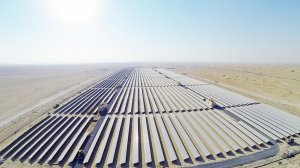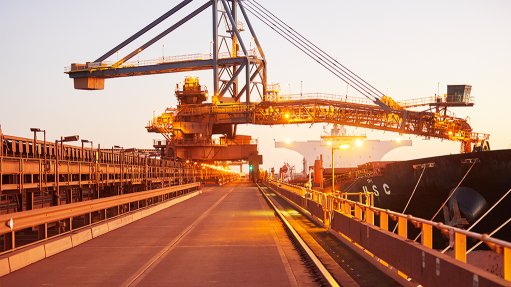First Solar unveils diesel-replacement strategy for African mines


The DEWA 13 solar facility, in Seih Al Dahal, about 50 km south of Dubai, in the UAE
Thin-film solar company First Solar is aggressively pursuing build operate and own (BOO) fuel-replacement projects in the global resources sector and is offering miners the prospect of displacing diesel through the use of increasingly cost-competitive solar energy.
The Nasdaq-listed group recently appointed an executive with the specific mandate of promoting these hybrid solutions and also confirmed that its $1-billion-strong balance sheet could be leveraged in support of the strategy.
Fuel replacement solutions director John Eccles, who is based in Australia and who will be marketing the concept at the Mining Indaba, in Cape Town, reported that advanced discussions were already under way with multinational mining groups, with particularly strong interest being shown in Australia and Africa, including mining-heavy, but power-light South Africa.
In an interview on the sidelines of the World Future Energy Summit, held in Abu Dhabi, United Arab Emirates (UAE), Eccles said each project would be tailored to the mine’s specific power-load profile, as well as its expected life.
“It’s a commercial proposition whereby we take on the risk, which will ensure that the plant is not so small that it is being fully utilised, but not so large so that half of the asset is not being used. In fact, design optimisation is the first critical step with hybrid applications, even more so than with utility-scale projects,” Eccles outlined.
COST COMPETITIVE?
While variable in nature, the solar-hybrid offering has become viable mainly as a result of a material decline in the cost of solar photovoltaic (PV) facilities over the past five years.
Internal First Solar figures show that the levellised cost of electricity (LCOE) from its facilities currently stands at between $70/MWh and $150/MWh, making them comparable, or cheaper, than conventional power plants – the LCOE being the total cost of ownership over a plant’s life.
By way of illustrating this emerging cost competitiveness, the group, which is the largest solar-panel manufacturer in the US, started building a 22 MW plant in west Texas earlier this year in the absence of a power purchase agreement with a utility. Instead, the Barilla solar project in Pecos County, which would become operational by mid-2014, would bid its output into the State’s deregulated market.
The specific value proposition in the mining sector, however, was to introduce plants whose primary goal would be to secure supply over the life-of-mine, while reducing costs associated with diesel consumption.
In South Africa, such BOO projects would be pursued in parallel with ongoing work to position the company as a technology partner for any upcoming bidding rounds for additional solar PV capacity to be procured by the Department of Energy, Cape Town-based business development manager Laura Luckhurst added.
LOCAL CONTENT
The group, which has an installed base of 8 GW globally, had not participated in the first three bidding rounds under South Africa's Renewable Energy Independent Power Producer Procurement Programme, but was nevertheless paying close attention to the market.
Chief commercial officer Joe Kishkill said he expected South Africa’s solar PV market to emerge as the region’s single largest, with an installed capacity of 2.5 GW by 2017. For this reason, various localisation options were under review, owing to the high priority being given to local content in the South African adjudication process.
First Solar modules are currently made at factories in the US and Malaysia, but Kishkill said it was constantly assessing the trade-off between lower production costs and market access. He also stressed that, while the actual panels previously represented around 50% of the costs associated with a solar farm, the figure had fallen to between 25% and 30%. Attention was, therefore, also being given to the ‘balance of plant’ localisation options.
The group’s cadmium telluride (CdTe) solution would be particularly suitable to South Africa's high-temperature operating conditions, Luckhurst averred, noting that the module’s efficiencies were less sensitive to higher temperatures than was the case with the better-known crystalline-silicon modules.
During an exposure tour to the DEWA 13 solar facility, in Seih Al Dahal, about 50 km south of Dubai, in the UAE, director of projects Matthew Merfert indicated that high levels of plant performance were still being demonstrated even when ambient temperatures rose to above the 40 °C level and when panel temperature rose to well above 60 °C.
The 13 MW plant is currently the largest PV power facility in the region, covering an area of 238 764 m2, or the equivalent of around 33 football pitches.
Managed and operated by the Dubai Electricity and Water Authority, or DEWA, it is also the first operating facility on an area of 'desert pavement' earmarked for the proposed 1 000 MW Mohammed bin Rashid Al Maktoum Solar Park, named after Sheikh Mohammed bin Rashid Al Maktoum, ruler of Dubai and Vice President and Prime Minister of the UAE.
Completed in less than 30 weeks the plant comprises 152 880 CdTe PV modules, which were expected to generate about 24-million kilowatt-hours a year.
Any future BOO projects in the mining sector would incorporate the thin-film CdTe modules, into which First Solar had invested significant research and development (R&D) capital since the late John Walton, of the Walton family that founded Wal-Mart, made a significant investment in the company in 1999. That R&D effort was focused, global public affairs VP Maja Wessels outlined, on “cost reduction”, which remained the core thrust to this day.
Technology sales manager Nick Strevel added that the performance of the CdTe modules at high temperatures had emerged as a key competitive advantage, despite the continued dominance of crystalline-silicon modules globally. In high temperature and high humidity climates, plant’s using the thin-film solution reportedly produce up to 9% more energy yearly than competing plants with the same nameplate capacity.
The company is also optimistic that there is “significant headroom” to improve on that performance and to lower plant cost on a LOCE basis. And given the high-temperature environment in which many mines in Africa operate, First Solar was hopeful that its customised offering would prove popular.
“It's a new field globally and is being driven by the fact that, over the past five years, PV solar power prices have halved, while diesel fuel costs have generally increased. Over the past 12 months changes to those critical parameters have made hybrids viable,” Eccles concluded.
*Creamer attended the World Future Energy Summit as a guest of First Solar
Comments
Press Office
Announcements
What's On
Subscribe to improve your user experience...
Option 1 (equivalent of R125 a month):
Receive a weekly copy of Creamer Media's Engineering News & Mining Weekly magazine
(print copy for those in South Africa and e-magazine for those outside of South Africa)
Receive daily email newsletters
Access to full search results
Access archive of magazine back copies
Access to Projects in Progress
Access to ONE Research Report of your choice in PDF format
Option 2 (equivalent of R375 a month):
All benefits from Option 1
PLUS
Access to Creamer Media's Research Channel Africa for ALL Research Reports, in PDF format, on various industrial and mining sectors
including Electricity; Water; Energy Transition; Hydrogen; Roads, Rail and Ports; Coal; Gold; Platinum; Battery Metals; etc.
Already a subscriber?
Forgotten your password?
Receive weekly copy of Creamer Media's Engineering News & Mining Weekly magazine (print copy for those in South Africa and e-magazine for those outside of South Africa)
➕
Recieve daily email newsletters
➕
Access to full search results
➕
Access archive of magazine back copies
➕
Access to Projects in Progress
➕
Access to ONE Research Report of your choice in PDF format
RESEARCH CHANNEL AFRICA
R4500 (equivalent of R375 a month)
SUBSCRIBEAll benefits from Option 1
➕
Access to Creamer Media's Research Channel Africa for ALL Research Reports on various industrial and mining sectors, in PDF format, including on:
Electricity
➕
Water
➕
Energy Transition
➕
Hydrogen
➕
Roads, Rail and Ports
➕
Coal
➕
Gold
➕
Platinum
➕
Battery Metals
➕
etc.
Receive all benefits from Option 1 or Option 2 delivered to numerous people at your company
➕
Multiple User names and Passwords for simultaneous log-ins
➕
Intranet integration access to all in your organisation



















